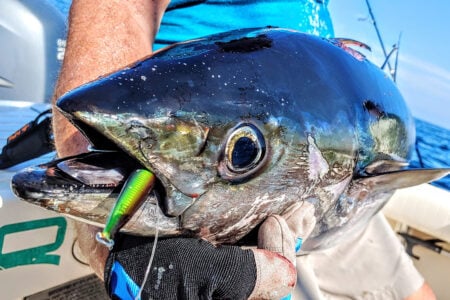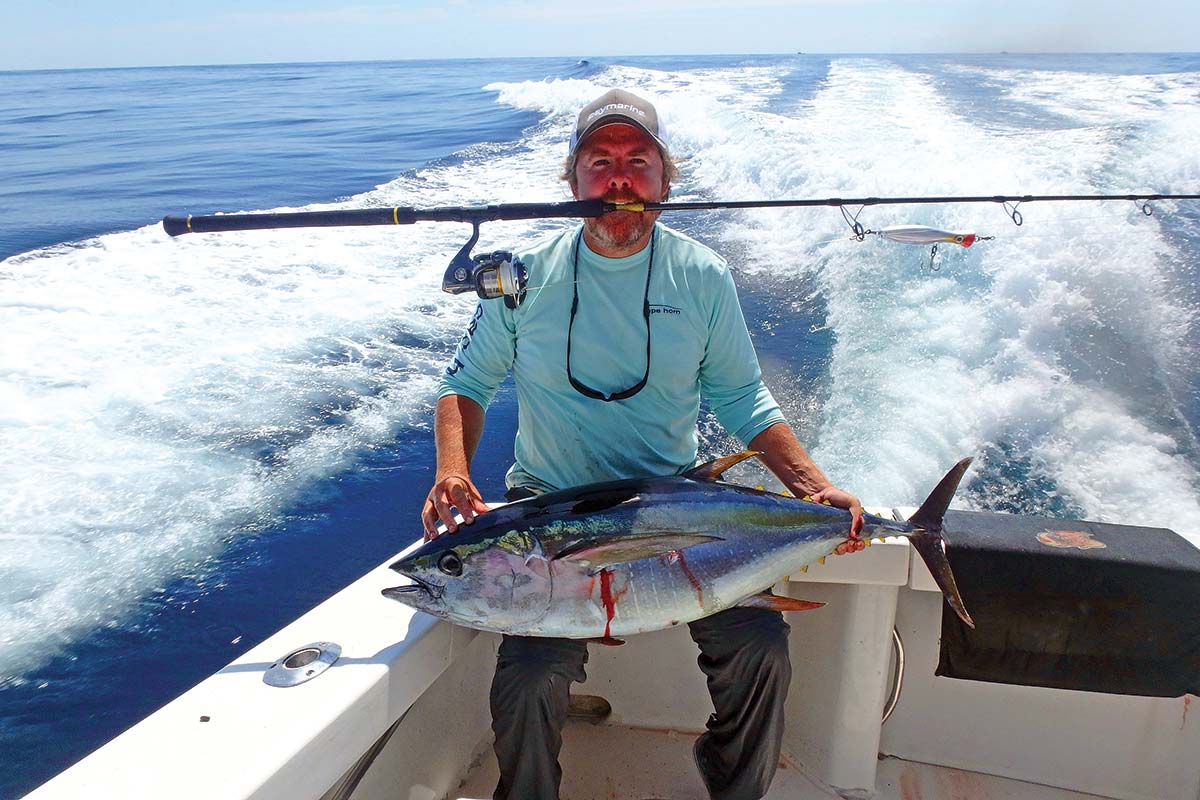
When popping, does bluefin verses yellowfin make a difference?
Throwing poppers to striped bass and bluefish is a lot of fun. However, watching a tuna explode on your popper ramps things up to a totally different level. With tuna fishing being fantastic over the last few years, a new breed of fisherman has emerged. These fishermen are willing to travel long distances with the attitude of “all or none.” Meaning if they can’t catch the tuna on a popper or jig, they are willing to come home with an empty fish box. I put a lot of time, money, and effort into my offshore trips. I want to ensure the people I’m out fishing with have every chance to catch fish. That means I need as many options as possible. I push off the dock with nine trolling setups, but I also have three popping and three jigging setups onboard. Starting in July, you will also find three mahi mahi spinning setups and two live bait/chunking setups. I believe it’s better to bend a rod on the troll than not to bend one at all. I’ll be honest with you though, when I push off the dock, I hope never to touch my trolling gear.
Poppers & Rigging

There are so many poppers to choose from. To name a few: Yo-Zuri Mag Popper, Madd Mantis Poppers, Nomad’s Chuck Norris Poppers, and Shimano Orca Poppers. The list goes on and on. Right now, several tuna fishermen are screaming at the top of their lungs, “How can this guy not mention the ‘so and so’ popper.” I get it, but when it comes to poppers, I would instead focus on making sure your terminal tackle on the popper you choose can handle the fish you are pursuing instead of listing every popper out there. There are a lot of lure manufacturers out there that sell their poppers without split rings and hooks. They leave it up to the fisherman to decide how they want to rig it.
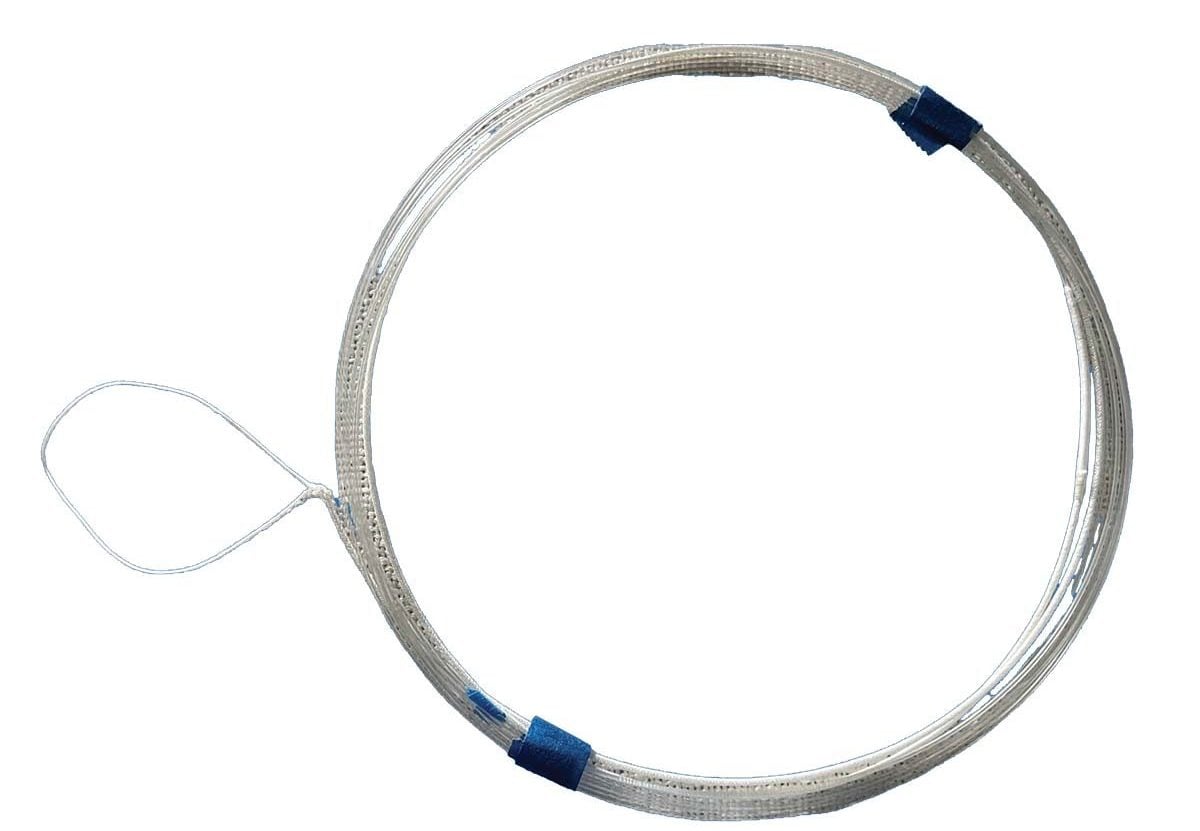
First, you must decide how big of a split ring you will use. In my neck of the woods (Long Island, NY), I use 220-pound split rings. Trust me, split rings matter. When I first started out, I landed a 70-pound bluefin on a popper. When the fish hit the deck, the popper fell out of its mouth, but the hook was still in the fish’s mouth. The split ring was mangled. Two years ago, I begged my buddy to change out his hooks and split rings as he put on a new popper right out of the box. Sure enough, he lost a nice bluefin when his split ring straightened out, and he watched the fish swim away.
The hooks you put on are as important as your split ring. When it comes to tuna hooks, it’s all about the strength of the hook. Make sure it’s at least 4x in strength. BKK makes my go-to hooks. When it comes to using trebles, I’m rigging up with either 2/0 or 4/0 BKK Viper-41 hooks. I realize that I will sound like Captain Obvious, but the size of the popper you use will determine the size of your hooks. If you choose to use single hooks instead of trebles, ensure your hooks face opposite directions. This will increase your hook-up ratio. Tuna are mean fish. They will test your tackle. Don’t let your terminal tackle let you down.
Chase Those Dolphins
Until last year, I didn’t pay much attention to dolphins that were on the move. I’m not talking about when you come across Nat Geo-type feeds where dolphins, birds, whales, and tuna are frenzying on the surface. Those types of feeds are what we hope to find when we push off the dock. I’m talking about dolphins that swim very fast and will blow by your boat in a matter of seconds.
| END OF THE LINE |
| The author uses loop to loop wind-on connections to attach his leader to 65-pound hollow core line. The leader is 60-pound fluorocarbon. The author also prefers to keep his leaders short to allow for maximum distance when casting. Most people that use solid braid will opt for the FG knot in place of a loop to loop connection. |
Last year after covering 40-plus miles of what seemed like a lifeless ocean, we came across a pod of dolphins that were on the move. I didn’t expect much, but I needed to stretch my legs, so I put the boat in front of the oncoming dolphin, and we launched three poppers. I was in total shock when a yellowfin came up and inhaled my popper. What a great way to start the day! A week later, the same exact scenario played out. This time I was a little more hopeful as our poppers hit the water. Sure enough, my buddy Hunter’s popper gets blown up. However, he didn’t come tight. But it’s a big ocean, and we just got confirmation that there were tuna under the dolphin. It was run and gun time, so I quickly turned the boat, pushed down on the throttle, and we were back in front of the dolphin in no time. The first popper that hit the water got smashed. This time it came tight. After about 20 minutes, we iced up a nice 70-pound yellowfin. Sadly the dolphins were gone by the time we were ready to chase them down again.
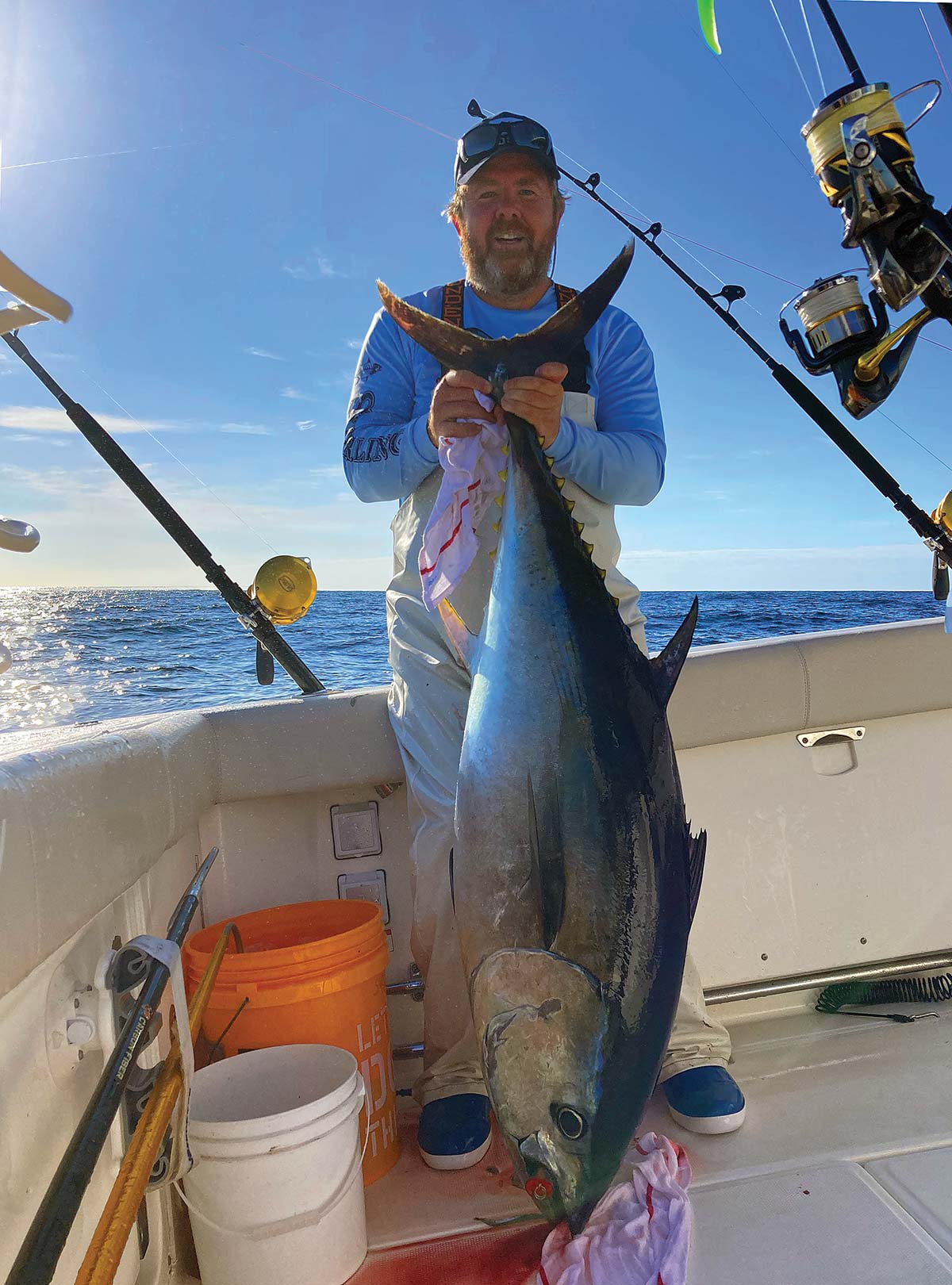
Don’t Forget Skipjacks
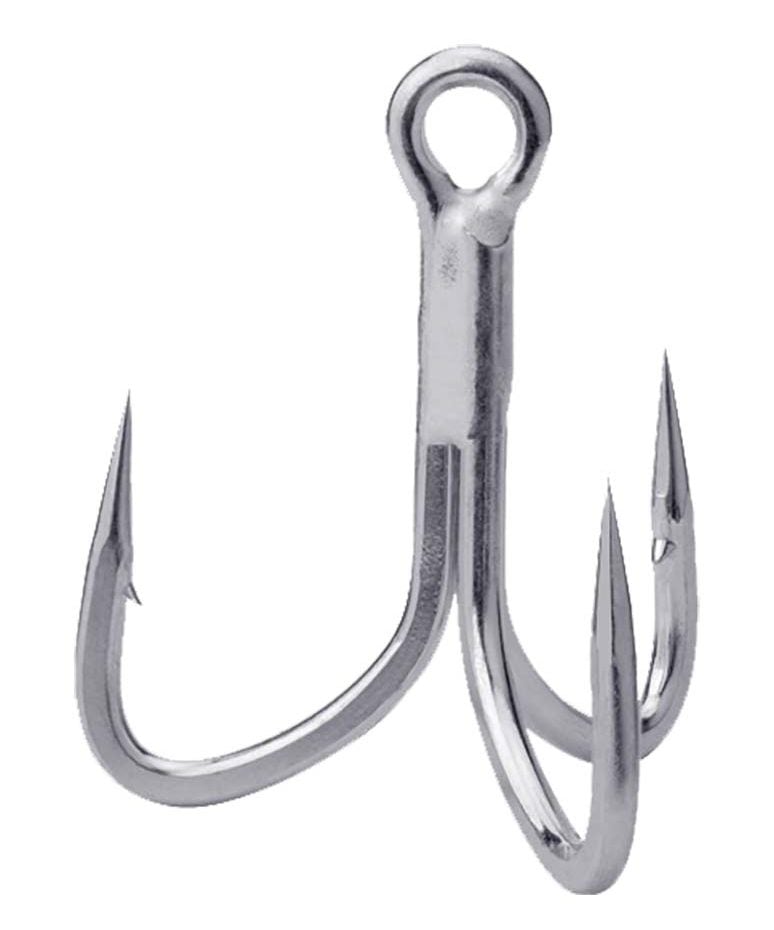
Just like what I wrote about dolphins, skipjack tuna must also be paid attention to. A lot of times, you will come across these speedsters feeding on the surface. Don’t expect birds or mammals to be accompanying them. You need to be patient and put your time in once you find skipjacks. Keep telling yourself that the ocean is huge and you just found some type of life.
On one trip that stands out, after hours upon hours of driving around a lifeless ocean, we came across a big school of skipjacks on the surface. It took a while, but we finally came tight on a popper. It ended up being a legal but small yellowfin. A small tuna on a popper is better than nothing. So we continued to cast our poppers. I was actually taking a break staring out, wishing one of the poppers would get exploded on, when a big bluefin tuna came flying out of the water. The hole this fish left in the water was massive. My buddy Chris’s reel began to scream. As fast as it happened, it was over. The popper came floating back to the top, and we were devastated. I was disappointed, but I wasn’t mad. On the ride home, I focused on the big picture. Not only was I right about yellowfin and bluefin tuna being found underneath skipjack tuna, but I learned that just because you are catching small tuna, it doesn’t mean there aren’t bigger ones among them.
Let’s Talk Rod & Reel
When it comes to tuna popping rods, there really isn’t a one size fits all. You will need to factor in a few things before you go shopping for one. Where are you going to fish? As I mentioned, I fish off Long Island, NY. The rod I use will not be a good fit if you plan on chasing giants up north. You don’t want to be over-gunned or under-gunned. Another factor, what’s more important: the strength of the rod once you are hooked up, or do you opt for being able to cast further? Usually, it’s one or the other. Shimano makes some excellent popping rod options, and more recently, St. Croix added the new Rift Series to their line, which has some suitable selections for tuna popping.
| BLUEFIN OR YELLOWFIN? |
| I often get asked if I do anything different when it comes to targeting yellowfin or bluefin. Personally, I do not, however, I will say from what I have witnessed, I feel that yellowfin seem to be a little more likely to hit a popper. Whether it’s bluefin or yellowfin, most of the time, your hook-ups will occur when your popper is just sitting there in between pops. Before I talk a little tackle and cover a few scenarios, I will state the obvious. The more poppers hitting the water, the better your chances of hooking up. A head boat with 75 people targeting striped bass with diamond jigs will draw a lot more attention than you and your buddy fishing in your boat. It’s a simple concept — six poppers in the water will get more attention than one or two poppers will. |
Just like lures and rods, there are plenty of reels to choose from. Where I fish, there are plenty of fishermen that will use 8k and 10k size reels. Up north, where much larger fish are common, 18k and above are usually the go-to size reels. I decided to split the difference, and I used a 14k size reel. Popping takes a lot of energy. It’s not easy to stand for hours and constantly throw and work a popper. So it’s important to keep in mind the weight of the reel will have a huge impact on how long you can stand at the rail throwing a popper. It may not sound like a lot, but a 7- to 8-ounce difference in weight makes a huge difference. Of course, I can’t discuss reels without mentioning ratios. The reels I use (Shimano Stella 14k and Twin Power 14K) are considered high-speed ratio reels. Both reels have a ratio of 6.2:1. That means for every full turn of the reel, the spool spins 6.2 times. It may seem hard to believe, but the reels pick up 53 inches of line per turn. So why is this important? Throwing poppers involves a rhythm. Every time you try to pop your lure, you need to make sure you don’t have slack in the line. If you do, you will never be able to work your popper correctly. What ends up happening is your popper will do a summersault across the top of the water.
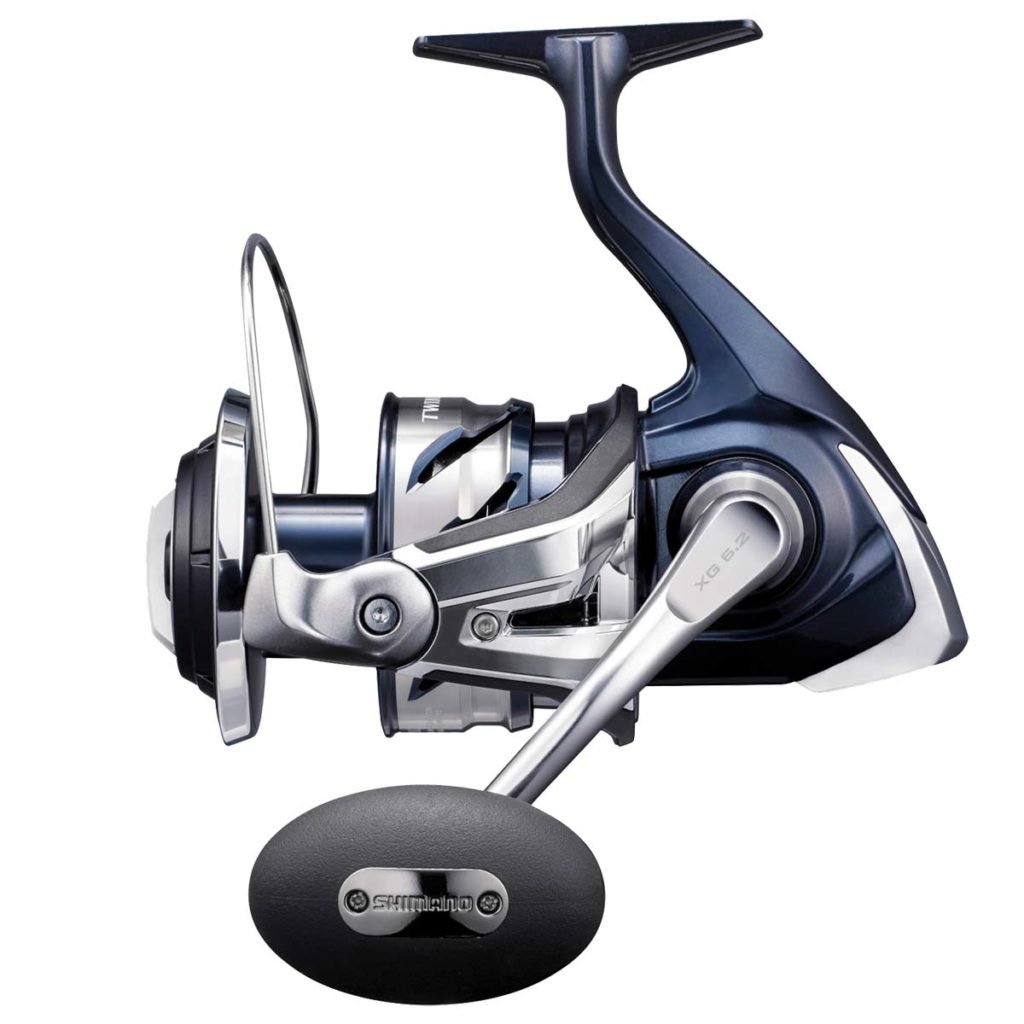
I didn’t want to bore you with just writing an article that only talks about which tackle to use. You can literally write page after page about which gear to buy. So I opted to split this article up with some in-the-field scenarios and tackle to tackle them. The more “arrows you have in your quiver,” the more fish you will catch. Every time I push off the dock, I’m trying to learn something new. You can buy all the top-of-the-line tuna gear you want, but if you don’t recognize opportunities, you are just wasting your time and money. As I wrote earlier, the ocean is a huge place. Anything that’s alive out there needs to be investigated.


